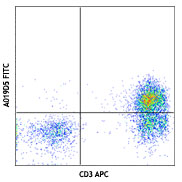- Regulatory Status
- RUO
- Other Names
- TNF-α, IL-13, IL-4, IL-10, IL-6, IL-2, TNF-β, IFN-γ, IL-17A, IL-12p70, APRIL (CD256), BAFF (CD257) sCD40L
- Ave. Rating
- Submit a Review
- Product Citations
- publications
Human B cells, also known as B lymphocytes, are white blood cells that play key roles in adaptive immune responses. They function in the humoral immunity component of the adaptive immune system by secreting antibodies, and are also classified as professional antigen presenting cells (APCs). In addition, B cells also secrete an array of cytokines that mediate Th1- and Th2-like immune responses.
The LEGENDplex™ Human B Cell Panel (13-plex) is a bead-based multiplex assay panel, which uses fluorescence-encoded beads suitable for use on various flow cytometers. This Panel focuses on 13 key targets involved in B cell function, activation, proliferation, and survival. It allows simultaneous quantification of 13 human cytokines, which include: TNF-α, IL-13, IL-4, IL-10, IL-6, IL-2, TNF-β, IFN-γ, IL-17A, IL-12p70, APRIL, BAFF, CD40L, and are collectively secreted by Be1, Be2, Breg, CD4+ lymphocytes, dendritic cells and monocytes. It provides higher detection sensitivity and broader dynamic range than traditional ELISA methods. This panel has been validated for use on cell culture supernatant, serum, and plasma samples.
The LEGENDplex™ Human B Cell Panel is designed to allow flexible customization within the panel. It can also be divided into sub-panels, such as:
LEGENDplex™ Human B Effector 1 (Be1) Panel (4-plex)
LEGENDplex™ Human B Effector 2 (Be2) Panel (5-plex)
LEGENDplex™ Human B Effector 1/2 (Be1/2) Panel (9-plex)
LEGENDplex™ Human B Cell Activator Panel (3-plex)
Please visit www.biolegend.com/legendplex for more information on panel design and how to mix and match within the panel.
Kit Contents
- Kit Contents
-
- Setup Beads: PE Beads
- Setup Beads: Raw Beads
- Capture Beads
- Detection Antibodies
- Standard Cocktail, Lyophilized
- SA-PE
- Matrix B7, Lyophilized
- Assay Buffer
- Wash Buffer
- Plate Sealers
- Filter Plate
Please note: Lots manufactured before September 2021 may include a different version of the “Matrix B.” There is no change in the protocol. Simply use the Matrix reagent you received as suggested in the current manual.
Product Details
- Verified Reactivity
- Human
- Additional Product Notes
-
View more applications data for this product in our Scientific Poster Library.
- Product Citations
-
- Materials Not Included
-
- Flow Cytometer
- Pipettes and Tips
- Reagent Reservoirs for Multichannel Pipettes
- Polypropylene Microfuge Tubes
- Vortex Mixer
- Sonicator
- Aluminum Foil
- Absorbent Pads or Paper Towels
- Plate Shaker
- Tabletop Centrifuges
- A Vacuum Filtration Unit and a Vacuum Source (if using filter plates)
- Manual
Antigen Details
- Biology Area
- Immunology
- Molecular Family
- Cytokines/Chemokines, Growth Factors
- Gene ID
- 7124 View all products for this Gene ID 3565 View all products for this Gene ID 3586 View all products for this Gene ID 3569 View all products for this Gene ID 3558 View all products for this Gene ID 4049 View all products for this Gene ID 3458 View all products for this Gene ID 3605 View all products for this Gene ID 3592 View all products for this Gene ID 3593 View all products for this Gene ID 8741 View all products for this Gene ID 10673 View all products for this Gene ID 959 View all products for this Gene ID
Related Pages & Pathways
Pages
Related FAQs
- If I don't have a vacuum, how do I remove the liquid from my plate?
-
If you do not have a vacuum, the assay should be run in a V-bottom plate. After centrifugation using a swinging-bucket rotor with a plate adaptor, you can remove the liquid by flicking the plate quickly, dumping the contents into a sink, and patting it dry carefully on a stack of clean paper towels without losing the beads. Alternatively, you can remove the liquid by using a pipette.
- Should I perform the assay with the filter plates or with V-bottom plates?
-
Filter plates or V-bottom plates have been included in some kits for your convenience. A vacuum filtration unit is required to work with the filter plates. However, if you don’t have access to a vacuum manifold or if you prefer, then you can use the V-bottom plates and follow the recommended assay protocols for the type of plates you choose. All plates should be made from low binding polypropylene. Polystyrene ELISA or cell culture plates should not be used.
- After I finish the staining process, how long can I wait before reading my LEGENDplex™ samples?
-
The samples can be kept overnight at 4°C while being protected from exposure to light and be read the next day. There may be a decrease in signal, but overall, the assay results should not be affected. Storing the samples for extended periods of time is not recommended, as it could lead to further reductions in signal.
- What is the shelf life of LEGENDplex™ kits?
-
LEGENDplex™ kits are guaranteed for 6 months from the date of receipt, but may have a shelf life of up to 2 years from the date of manufacture.
- Is special software required for data analysis?
-
Typically flow cytometers generate output files in FCS format (e.g. FCS 2.0, 3.0, or 3.1) and in some cases in list mode file format (LMD). Other software may be available to analyze FCS files. Data generated using LEGENDplex™ kits can be analyzed using the freely available LEGENDplex™ data analysis software. Please check our website for the most updated versions of the software.
 Login / Register
Login / Register 












Follow Us